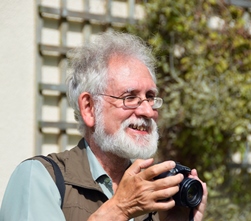 Distinguished Cretaceous stratigrapher and consummate editor with a passion for detail, who survived nearly being buried alive in a sand-pit.
Distinguished Cretaceous stratigrapher and consummate editor with a passion for detail, who survived nearly being buried alive in a sand-pit.
‘Chris’ to all his family, friends and colleagues enhanced the world of Cretaceous research for nearly 50 years. He died of cancer in hospital in Taunton, Somerset, 27 January, 2016.
Chris went to the same school in Hertfordshire as Richard Bromley and Jack Doyle and all three went on to become Cretaceous geologists of note, having first been stimulated by finding fossils in their school long-jump sand pit and then in their local Chiltern Hills Chalk pits.
Chris studied geology at Reading University and then joined the British Geological Survey as their Cretaceous Palaeontologist based at the Geological Museum (now part of the Natural History Museum) in Exhibition Road, London.
When BGS moved to Keyworth, in Nottinghamshire, Chris chose to take redundancy, giving him time to focus on his immense collaborative work with the Cretaceous Working Groups worldwide, especially with his German colleagues.
Editor
In his final years he was a key editor and reviewer for the journals Cretaceous Research and Acta Geologica Polonica, spending many long hours helping authors convert their manuscripts into perfect English. He was a tenacious and ‘picky’ reviewer, demanding the highest standards of scientific accuracy and his favourite phrase, ‘you cannot say that…’, will be long remembered.
In his early years as a professional geologist he was lucky to survive a life-threatening accident when he was buried by sand in a trial pit excavated in the Haldon Greensand in SE Devon that collapsed, burying him completely. A quick-thinking Chris stuck his hand in the air with his pencil sticking upwards and this was all his rescuers could see. The excavator driver and those with him managed to quickly extricate him but the weight of sand had partially crushed his skull (despite wearing a helmet). This accident affected his eyesight and in later years he found it very difficult to use a microscope and he suffered from severe headaches.
Chris’s contribution to the geology of the UK has been immense and included many of the seminal BGS reports and memoirs on the Cretaceous of Northern Ireland and of England. His work in Lincolnshire and Yorkshire led to the new lithostratigraphy and maps for the Northern Province of Lincolnshire and Yorkshire. His contributions to understanding the Cretaceous of East Anglia and to inland Dorset have been equally important. In the international arena, Chris worked since the 1970s on the various Cretaceous Working Groups and as a voting member contributed to the decisions on the stage and substage divisions of the Cretaceous.
Chris was slight of build but this hid a steely determination and physical endurance. As part of preparing the book ‘British Upper Cretaceous Stratigraphy’ it was necessary to re-measure all the Cretaceous field sections in the Inner Hebrides. One section on the northeast side of Beinn Iaidain in Morvern, required a long trek across typically mountainous, rough, boggy ground in extremely wet weather.
Having dug out, measured and collected the vital samples from the section, the trek back in a virtual ‘white-out’ was only navigable by following the torrent along the contact between the Moine schists and Mesozoic rocks. The durable Chris managed this arduous trek at the age of 60 with relative ease, revived at the end by a large glass of whisky.
He was not averse to stripping off to his underwear and diving into cold Scottish burns to dig out vital evidence. Wherever he was working, his desire for accurate detail led him to spend many hours if not days on the same stratigraphical horizon, painstakingly taking it apart until he was satisfied all possible evidence had been collected.
Minehead
In his last years Chris moved with his partner Jenny and family from South Croydon to Minehead, Somerset. Chris, in addition to maintaining his geological editorial work became an influential member of the Town, helping to set up and run the U3A geology group and furthering his great interest in birdwatching (owls being especially important) and recording wildlife, including active participation in the U3A photography group.
Chris was proud to be a member of the enthusiastic team that initiated the first-ever Minehead Museum in March 2014. It was a tribute to his wide interests and contributions to science and to his local society that a celebration of Chris’s life (held in Minehead on 11 April 2016) included so many speakers from geology and the town of Minehead, including the Somerset Wildlife Trust, Minehead and District U3A, Amnesty International, West Somerset Labour Party and local archaeologists whom he had helped.
Tributes had also been sent from his many colleagues in Europe including the German Cretaceous Subcommission on which Chris was a full voting member.
Chris will be remembered as a very loyal friend, generous with his time and knowledge, as a consummate editor, outstanding palaeontologist and excellent field geologist. It is fitting that in his last months the Yorkshire Geological Society awarded him the John Phillips Medal for his major contributions to the Yorkshire Cretaceous. Despite being very weak from cancer, Chris made the journey from Somerset to Yorkshire and gave a marvellous acceptance speech.
Chris is survived by his partner Jenny Lennon-Wood, stepdaughter Siobhán with husband Steve and their son Lorcan to whom Chris was ‘Owlpa’.
Christopher John Wood: born 18 August 1939; died 27 January 2016.
Rory Mortimore
Save